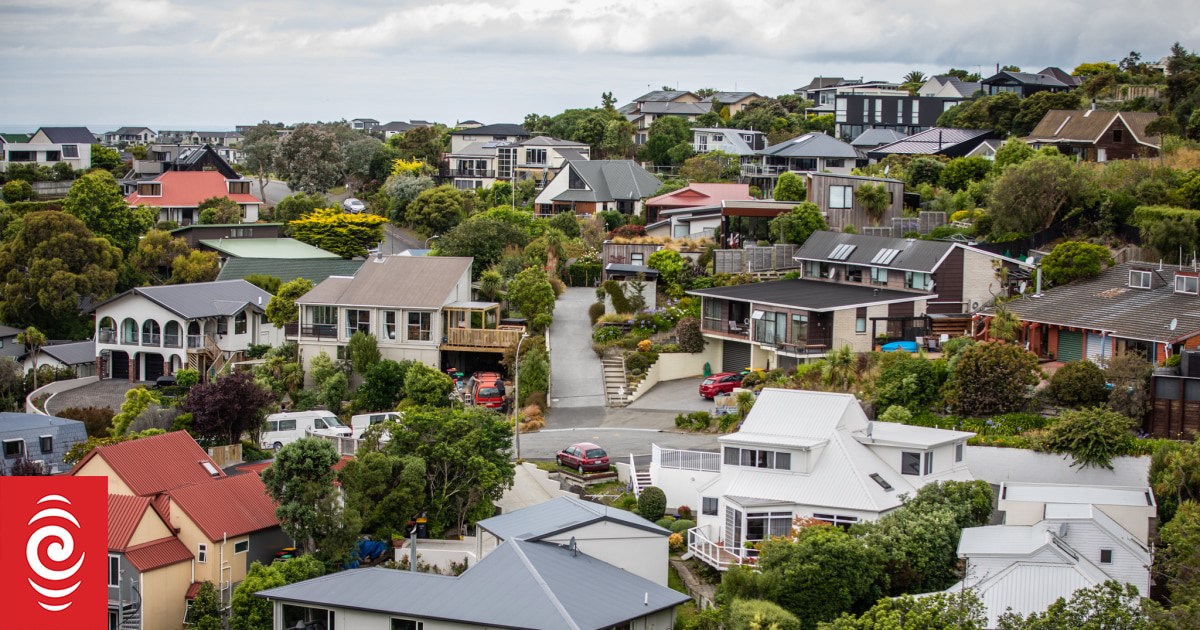
It’s not a great time to sell a home, unless you have real motivation to do so, one expert says.
Photo: RNZ
A surge in houses being listed for sale continues – and in some cases, it is because people are selling before they are forced to, some real estate market participants say.
The Real Estate Institute noted “high interest rates” as a reason for properties coming on to the market when it released its June data. The number of new listings was up 25.5 percent, year-on-year, even as sales decreased by roughly the same percentage.
At Realestate.co.nz, spokesperson Vanessa Williams said the wave had continued through July. She said there had been a “big jump” in listings in the first two weeks of the month compared to the same time last year, up almost 49 percent. She said she, too, had heard interest rates were a driver.
Whangārei real estate salesperson Brooke Gibson said interest rate stress was “so real” for sellers, particularly those who bought homes at “extravagant” prices when interest rates were low, or who borrowed against their homes during that period.
“People were buying properties at outrageous prices and now they’re having to take a major hit on the price.
“They’re also in a position where they have to sell because they can’t afford the payments based on the fact interest rates have gone from 2 percent to 9 percent in some cases and their house prices might have dropped 20 percent.
“It’s a really tricky situation.”
She said she had had several clients who had said if she was not able to sell the house, it would be turned into a forced sale.
“I’ve had a [person] saying ‘Brooke is going to sell it or the bank is’… it’s something I’ve seen numerous times.”
Kelvin Davidson, chief property economist at property research firm CoreLogic, said sales due to interest rate stress were often a lagged indicator, because it took time for people to get through savings and other options before they reached a point where they had to sell.
He said it seemed that banks were also doing their best to help people who were in hardship. Mortgagee numbers remain low – there were 24 in the first quarter of this year compared to more than 750 a quarter during the global financial crisis peak.
Centrix data in June showed 22,000 home loans were past due, up 12 percent year-on-year and at pre-pandemic levels.
“Interest rates have been pretty high for a long time. You hope that people get through, but the longer they stay at this level, there’s always a risk of stress coming through.”
He said some of the increase in listings could also be investors who were no longer captured by the bright line test. As of 1 July, investors only had to hold a property for two years to avoid an automatic tax on any gains from the sale.
Davidson said it did not seem like an environment in which people would try to sell if they did not have real motivation to do so.
“I don’t think you just try to sell on a whim at the moment.
“You wouldn’t just test the market, there are so many other listings out there. But there are always people who have to sell, life still happens.”
He said if people could hold on a bit longer, the next time they repriced their home loans, interest rates could have started falling: “Hang on a few more months and we’ll probably be through the worst of it.”
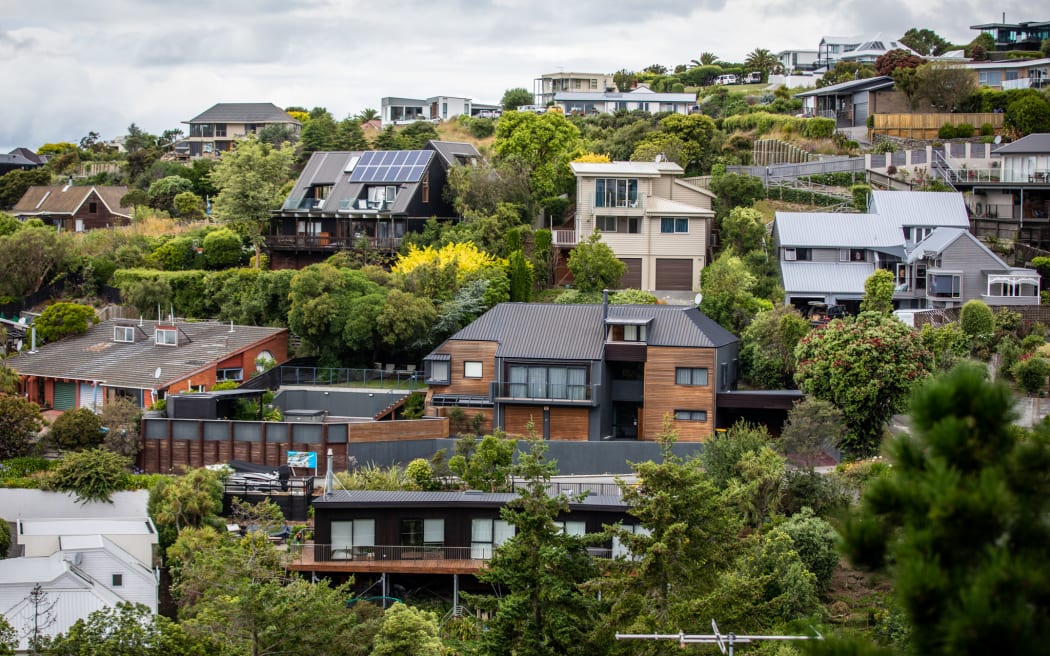
Canterbury is bucking the national trend, with house sales up 5 percent year-on-year. (File photo)
Photo: RNZ / Nate McKinnon
The housing market cooled further in June, with prices and sales falling, while buyers have more options as listings continue to rise.
The Real Estate Institute’s house price index – a measure of the changing value of properties – fell 0.7 percent from a month ago, but rose just over 1 percent from a year ago.
The national seasonally adjusted median price fell 1.3 percent from a year ago and was flat from May to be $770,000.
In Auckland, prices rose 2.4 percent from a month ago and were up nearly 5 percent from a year ago, to a median price of $1.05 million.
Sales counts fell 15 percent from a year ago, and the national inventory level increased 29 percent from a year ago, while listings rose 26 percent.
“The increased number of listings coming to market continues the trend we have seen all year, with high levels of choice for buyers nation-wide. The winter months do tend to see fewer people choosing to sell, and this year is no different,” Real Estate Institute chief executive Jen Baird said.
“Salespeople are seeing some properties come to market due to high interest rates, cost of living pressures and changing employment circumstances,” he said.
Nationally, the median days to sell rose by one day to 48 days.
Baird said there was a “notable decrease in buyer activity” and a “reduced sense of urgency”.
“As more listings come to a well-stocked market, those who are in the position to buy are taking their time to carefully select their ideal home,” she said.
Seasonally adjusted median price movements (selected regions)
- Auckland – up 2.4 percent from May, up 4.8 percent from June 2023
- Waikato – down 1.3 percent from May, down 2.3 percent from June 2023
- Bay of Plenty – down 4.3 percent from May, down 6 percent from June 2023
- Wellington – up 0.8 percent from May, up 2 percent from June 2023
- Canterbury – up 1.6 percent from May, up 5 percent from June 2023
- Otago down – 5.3 percent from May, down 3.8 percent from June 2023
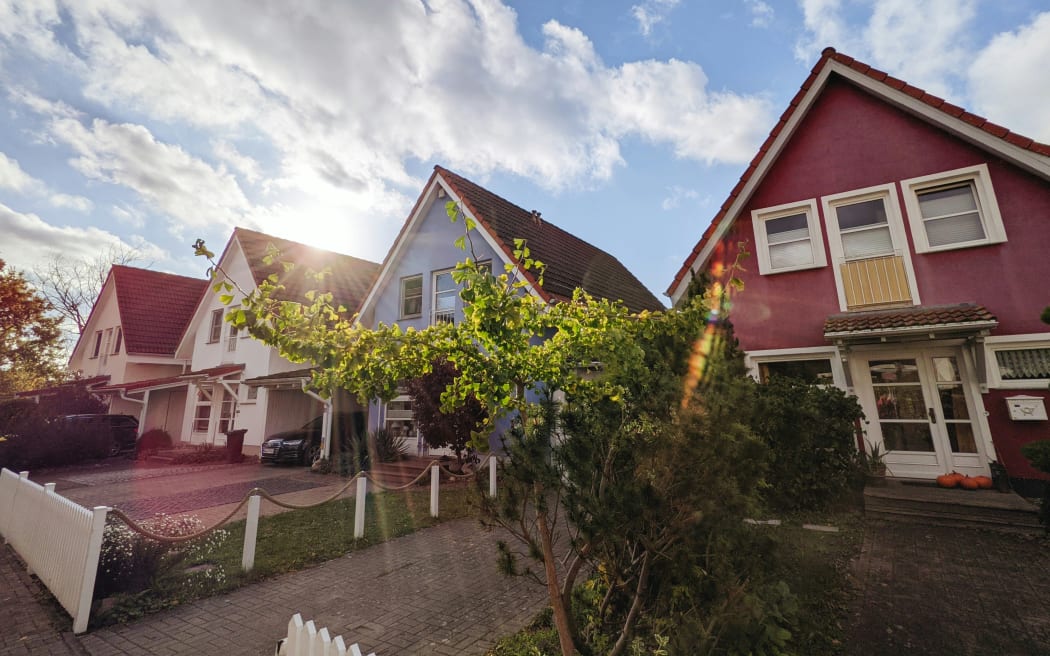
Photo: Unsplash / Paul Kapischka
Fewer homeowners are becoming “accidental landlords” as the property market slows, new data from CoreLogic shows.
The term refers to people who end up renting out a property that they had intended to sell, because they could not find a buyer.
CoreLogic data provided to RNZ shows that in the year to June 2021, about 5.3 percent of all listings were withdrawn and then offered for rent, or 5500 properties.
But at the end of March 2023, and since then, the count for the previous 12 months had remained below 1600, or about 2 percent of listings.
CoreLogic head of research Nick Goodall said the fact people were opting to sell instead of rent more often as the market weakened was not what he had expected to see.
“My hypothesis for this is that when values are increasing, they can set a high expectation on a price they’ll accept and if they don’t get that offer, they’re happy to continue riding the upswing and take it to the rental market in the meantime.
“Then when value growth is slowing or falling, the motivation to accept a price is higher so fewer properties are held and then taken to the rental market. “
Data earlier provided by Opes Partners showed that about 35 percent of homes listed for sale in Auckland and 45 percent in Northland were being pulled from the market without selling.
However, about 90 percent of Wellington properties were successfully sold.
Goodall said it was probably the case that the people withdrawing were mostly owner-occupiers who could decide to stay put rather than sell, not people who had to move because they had already bought somewhere else and were leaving the house vacant, or investors selling.
“I wonder if it also speaks to the fact it’s quite difficult to get bridging finance. The willingness of people to go out there and buy a property before they sell their old one, this maybe proves that’s quite low and people don’t do it. They end up selling before buying or it’s all conditional so you never actually have two properties which would be the situation that would lead you to be an accidental landlord.”
People might also be less likely to buy a new place before they sold their existing one in an environment where prices were changing and they were not sure what they would get as a sales price.
Auckland Property Investors Association general manager Sarina Gibbon said the people she saw becoming “accidental landlords” were mostly going overseas for work.
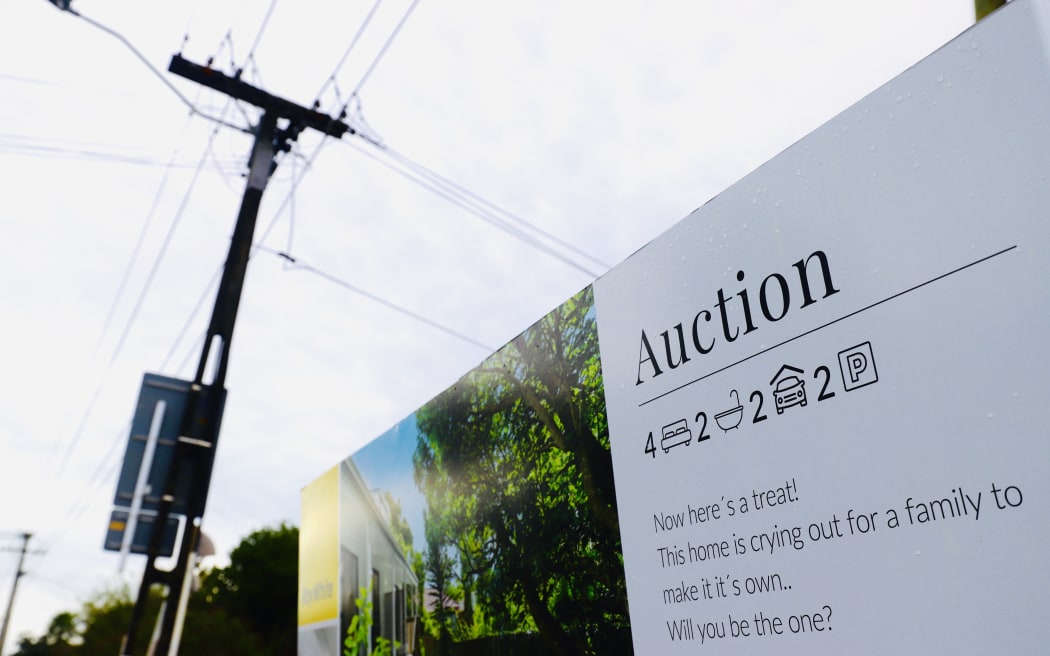
Rental yields – the measure of rent an investor can receive compared to the property purchase price – has dropped significantly over the years, according to Opes Partners economist Ed McKnight. (file image)
Photo: RNZ / Marika Khabazi
Most investors buying properties now are banking on capital gains to make them pay off.
But there is a warning that anyone expecting a repeat of the capital gains seen over recent decades could be disappointed.
About 20 percent of sales are currently to property investors. But Opes Partners economist Ed McKnight said data showed about 93 percent required the investor to “top up” the mortgage payments, assuming the full purchase price was borrowed.
Rental yields – the measure of rent an investor could receive compared to the property purchase price – had dropped significantly over the years, he said.
Someone buying a nationally median-priced house in 2000 might have paid about $170,000 and rented it for the national median of about $200 a week.
Now, that same property might be worth $770,000 and rent for more like $600.
“Historically, 10 percent was what people aimed for, you would be very, very, very hard pressed to get that now. Less than one in 200 properties in New Zealand have a 10 percent rental yield or higher, the average is closer to 4.2 percent.”
He said that meant most investors were relying on capital gains to make it worthwhile.
“Even at a 5 percent rental yield, if you’re borrowing all the money to invest, you could be paying about 7 percent [for that] at the moment.”
Investors accepted they would have to top up their mortgage payments, he said.
Many were hoping that as interest rates fell, house prices might lift and the investments would fare better.
Corelogic research head Nick Goodall agreed investors were buying for long-term growth.
“It’s hard to see if you purchased an investment property today how you would make that stack up based on how much you’re paying on mortgage interest.”
But he said debt-to-income ratios could change the trajectory of capital growth, because they would tie how fast house prices could rise to incomes. Price growth rates could drop from 6 percent to 7 percent, to more like 3 percent or 4 percent a year over the longer term, he said.
“Investors cannot build the size of their portfolio as fast because their income has to keep up with the increases in debt levels. Expectations need to be reset.”
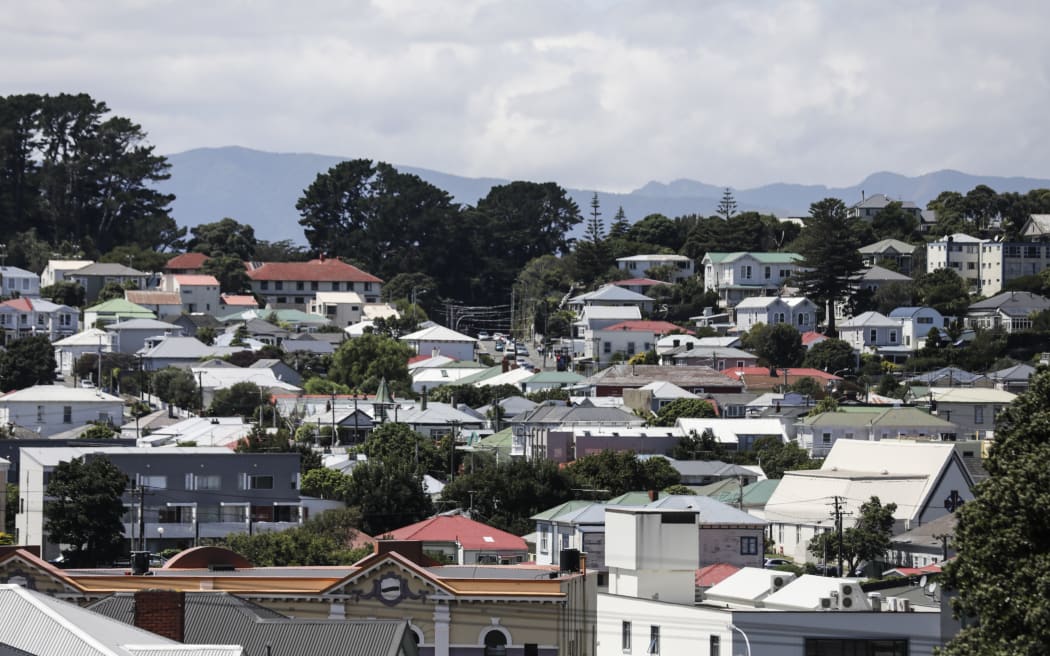
Corelogic research head Nick Goodall says it will be particularly important to investors to be sure they can find tenants, because higher mortgage repayments made vacancies harder to cover. (file image)
Photo: RNZ / Rebekah Parsons-King
ANZ senior economist Miles Workman said changes such as the government’s plans to free up more land and allow more density would probably also make housing more affordable than it otherwise would be.
“Maybe there is a new paradigm shift. More housing supply is on the way, maybe the capital gains won’t be as strong as they have been in the past.
“Some people out there have seen it as an investment channel that’s reasonably easy to understand and maybe the sector is relatively safe, but it doesn’t necessarily mean the dynamic will continue in terms of the capital gains side of it.”
Goodall said there were still ways investors could make it work but it would often involve identifying properties which could be improved to raise the value or the rent which could be charged, or finding “pockets of value”.
But at the moment, it would be particularly important to investors to be sure they could find tenants, because higher mortgage repayments made vacancies harder to cover, he said.
Rent growth was likely to slow, he said, because it was closely tied to tenant income. While incomes had been increasing quickly, the pace had now eased.
“Yields are likely to improve but not at a dramatic level unless we see house prices not increase very much for a sustained period of time.”
People’s attitudes to property investment were changing, Goodall said. While it was previously seen as one of the few ways New Zealanders could invest for retirement, there were now more opportunities, he said.
But the ability to borrow money to get into property still made it an attractive option for some people, he said.
If an investment in shares doubled in value, it might double what the investor put in. But if someone borrowed 80 percent of the cost of an investment that then doubled in value, they could get back many times their initial investment.

Property investor Nick Gentle says once the Baby Boomer generation sells down, there will be more opportunities to improve the old housing stock. (file image)
Photo: RNZ / Dan Cook
Property investor and iFIndProperty co-owner Nick Gentle said it was usually only easy to identify the good times to have invested in hindsight.
“I started after the GFC [global financial crisis]… in hindsight there were opportunities but at the time it was hard to see. The more experienced you are, the better you are at seeing opportunities.”
People who were breaking even on an investment now would see things improve over time, he said.
“The last cycle played out over a decade, we’re in year two [of this one]. More people will return. At the other end, we’re going to have the Baby Boomer generation selling down, a lot of them owned property for a long time and didn’t do much to it, so there will be a lot of opportunities to fix up and improve old housing stock.”
Infometrics chief forecaster Gareth Kiernan said there would “almost certainly” be an upswing in the housing market at some point, which would drive faster price growth.
But whether investors could hang in there while they waited was the question.
“At this stage, it’s hard to see what the catalyst might be, given the weakening labour market, slowing net migration, and limited signs of interest rate relief. If any material upswing in house prices is, say, three or more years away, then the question starts to become whether investors have the means – and the stomach – to keep topping up the mortgage while the value of their asset is drifting sideways.”

(File image).
Photo:
A rise of mortgagee sales is only the beginning of a “painful period”, as one property expert warns that “it’s going to get much, much worse”.
While not at the levels seen during the Global Financial Crisis, mortgagee sales have been climbing.
Sixty-five residential properties are currently listed as mortgagee sales on Trade Me property, a 35 percent increase on the same time last year.
One real estate regional manager in Wellington told RNZ his team normally appraised up to three properties a year for potential mortgagee sales – that was now up to three a month.
Property expert David Whitburn told Checkpoint business owners were among those feeling the pressure the most.
“We’ve seen over 50 companies across Aotearoa every week, going to the wall, facing either receivership or liquidation and often they’re securing their own home that they’ve put up as collateral for their business debt.
“Homeowners and property investors are not immune to this too.”
He believed the issue was the sudden jump from extremely low 2-4 percent interest rates a couple of years ago.
Hindsight was a wonderful thing, Whitburn said, suggesting that the financial settings perhaps were not set quite right during Covid-19.
“People are struggling to keep their heads above water.
“I think we’re at the beginning of a painful period, it’s already started, but unfortunately it’s going to get much, much worse over the next six months or so.”
Whitburn said banks only used mortgagee sales as a last resort.
“The banks realise it’s not particularly palatable … they understand that these are often families that are involved.”
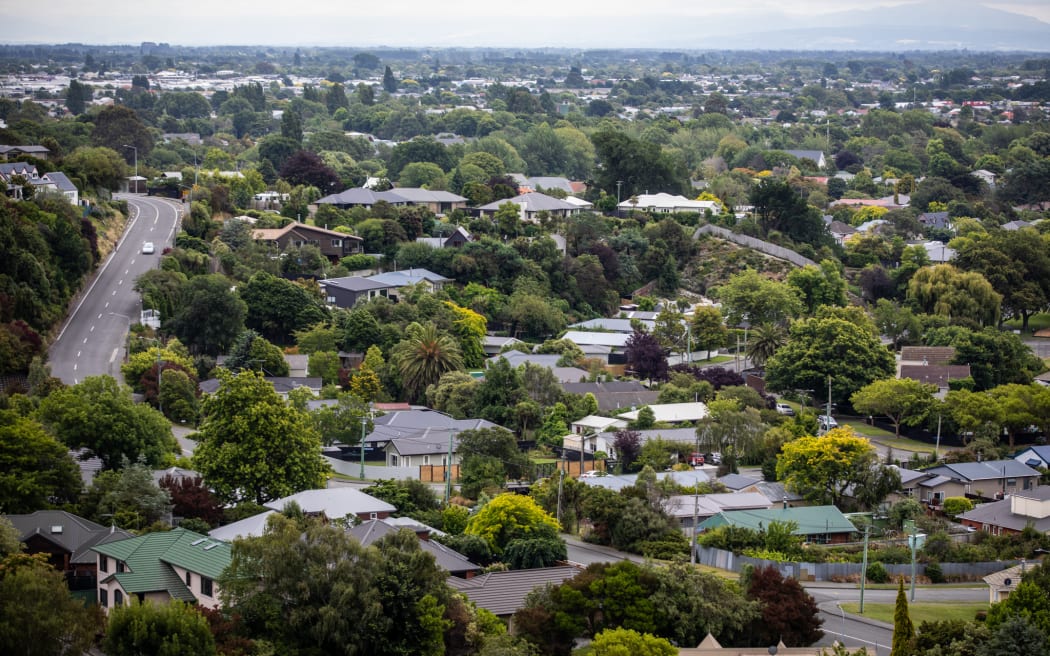
File photo.
Photo: RNZ / Nate McKinnon
The number of mortgagee sales looks to be on the rise – but they are still just a fraction of the total market, experts say.
A mortgagee sale happens when a homeowner does not meet their mortgage repayments, so the property must be sold to repay the debt owed to the bank.
TradeMe currently has 65 residential properties listed as mortgagee sales, which is 35 percent up on the same time last year.
But the site’s property sales director Gavin Lloyd said that number was “quite small” – less than one percent of TradeMe’s more than 42,000 property listings.
“In the market overall we are seeing properties generally taking longer to sell so this could also be contributing to the number of mortgagee listings increasing.
“We know it’s a tough time with the rising cost of living and interest rates taking its toll on homeowners, however mortgagee sales are often a last resort so some sellers may also look to proactively list their properties before they are required to by lenders.”
In Wellington, Bayleys regional general manager Grant Henderson said his team would usually appraise up to three properties a year for banks considering mortgagee sales.
But lately, staff were hitting that number each month.
“We’ve got a broad range, from developers who’ve found themselves in a sticky situation due to funding, we’ve found mums and dads that’ve got themselves just in the wrong situation, but also investors.
“People have probably let it all go too long, and there’s a lot of denial around the situation they’re in.”
Banks did not take such sales lightly, and it was an absolute last resort, he said.
“Based on some of the things we’ve seen, these people have been in financial difficulty for a long time, it’s not just like, ‘you lost your job last month, this month we’re gonna close you down’, this takes a long time for the banks … to get to the point where they have to pull the pin.”
People got plenty of warning and communication from the bank – up to three years’ worth – before they exercise their mortgagee rights and force a sale, said Henderson.
“Most pragmatic and practical mums and dads will get through it, but some people are just in that denial phase,” he said.
Climbing interest rates, insurance costs and council rates had been tipping homeowners into difficulty in recent times.
For those reason, an increasing number of mortgagee sales was not surprising, CoreLogic chief property economist Kelvin Davidson said.
But it was “nothing like” the peak in 2009 after the global financial crisis, which was an extraordinary period.
That year, New Zealand saw up to 800 mortgagee sales in a month, compared to 24 in the first quarter of this year, Davidson said.
Housing Minister Chris Bishop has told real estate agents that the government wants to “flood the market” with opportunities for housing development.
It has agreed to a range of changes that would free up land for housing, and, the government hopes, make housing more affordable.
Here is what is planned and how it might work.
Housing growth targets for tier one and two councils
Tier one (places like Auckland, Wellington, Christchurch and Tauranga), and tier two (places like Whangārei, Rotorua, New Plymouth, Dunedin) councils will have to “live zone” for land with enough feasible development capacity to cater to 30 years of housing demand at one time.
Live zoning means the land can be used under a plan that is already in effect, not planned to become available in future – feasible development refers to being commercially viable for a developer to undertake the work.

Infometrics chief executive Brad Olsen.
Photo: RNZ / Samuel Rillstone
A wider range of funding sources will be able to be used to meet medium-term infrastructure requirements. Prescriptive rules will be set for councils to determine how much capacity they need, such as requiring that they use “high” demand projections rather than more cautious estimates.
Infometrics chief executive Brad Olsen said it could be difficult for councils to allow for 30 years’ worth of development when the infrastructure was not yet there.
“But equally the infrastructure wasn’t there beforehand either, so at least with the more permissive options, it will force a greater need to develop infrastructure at a greater pace over time.”
New rules requiring cities to be allowed to expand out
Councils will not be able to impose rural-urban boundary lines in their planning documents, but they will still be able to have rurally zoned land.
Ministry officials are also looking at options to improve councils’ future development strategies, potentially requiring them to plan for growth over 50 years, not 30.
Strengthening of intensification provisions in the National Policy Statement on Urban Development (NPS-UD)
Tier one councils will have to enable “appropriate” levels of density across their urban areas, and they must deliver housing intensification along “strategic” transport corridors like major bus routes.
They must also offset, with more development elsewhere, any capacity they lose due to deciding some areas are “special character” and should not be intensified.
New rules require councils to enable mixed-use development
Tier one and two councils will need to allow things such as cafes, dairies and other retail in urban areas. Industrial activities will still be able to be kept away from housing.
No minimum floor area and balcony requirements
It will be up to developers, not councils, how big apartments have to be and whether they have a balcony.
Bishop said these requirements could significantly increase the cost of new apartments and reduce the supply of lower-cost apartments.
He said evidence from 2015 showed in Auckland, balcony size requirements pushed up the cost of an apartment by $40,000 to $70,000 per unit.

AUT professor John Tookey.
Photo: https://www.aut.ac.nz/
Bishop told the Real Estate Institute that people complained about shoebox apartments.
“I agree that they won’t be the right housing solution for everyone. But do you know what is smaller than a shoebox apartment? A car or an emergency housing motel room.”
AUT professor John Tookey said there would be questions around how far the rules were relaxed. “We might have to draw a line and say there needs to be toilet facilities separated off, for example.”
“What do we sacrifice on the altar of lowest cost?”
MDRS is made optional
The MDRS was the bipartisan agreement between National and Labour that was designed to allow for more density – enabling houses up to three-storeys without a resource consent.
All councils currently required to implement the MDRS will have to vote on whether they retain, alter or remove its standards from their areas.
If they remove or alter the MDRS they need to implement their housing growth targets, the intensification changes to the NPS-UP and the mixed-use provisions.
What will it mean for house prices?
Olsen said the plan would make a difference.
“We spend a lot of time talking about how awful the housing market is, how bad affordability is, I don’t know if that’s going to change immediately but I certainly feel more optimistic about the outlook for the future and that feels like a big thing to say.”
He said New Zealand had failed horribly at trying to dictate terms to the housing market, to the country’s’ “utter detriment”.
“Anything that will create more housing is a good thing, full stop.”
Tookey said it would probably lead to more apartments being built, if the new rules made it more profitable for builders to do so.
But he said the availability of more affordable apartments would not necessarily make other types of housing more affordable.
“We’re assuming they’re all competing in the same marketplace, and they’re not. People who want to buy a standalone property on a quarter-acre aren’t going to be competing in that space, anyway.”
Olsen said if apartments were what people needed, more would be built.
“It shouldn’t be up to us whether that’s good, bad or otherwise.”
Tookey said, for prices to fall, there would need to be more homes available than there was demand for them – and there was no guarantee that builders and developers would rush to build houses before there were sufficient buyers because it would reduce their margins.
“The way in which government could ultimately change the game is by using the power of the public purse to procure and build the right sort of houses in the right sort of places… Even if you went for 10,000 homes in a particular location you could actually get houses built ahead of the market.”
Corelogic head of research Nick Goosall said the changes were welcome.
“It’s the right thing to do.”
He agreed that any development would still need to stack up for builders and developers to make use of the new rules.
“It will take some time for them to have a major impact on the market. It’s definitely the right thing to do to say you can build in more places, make it more available, make it more palatable. As that demand comes, as it becomes more affordable, we’ll start to see them build off the back of that.”
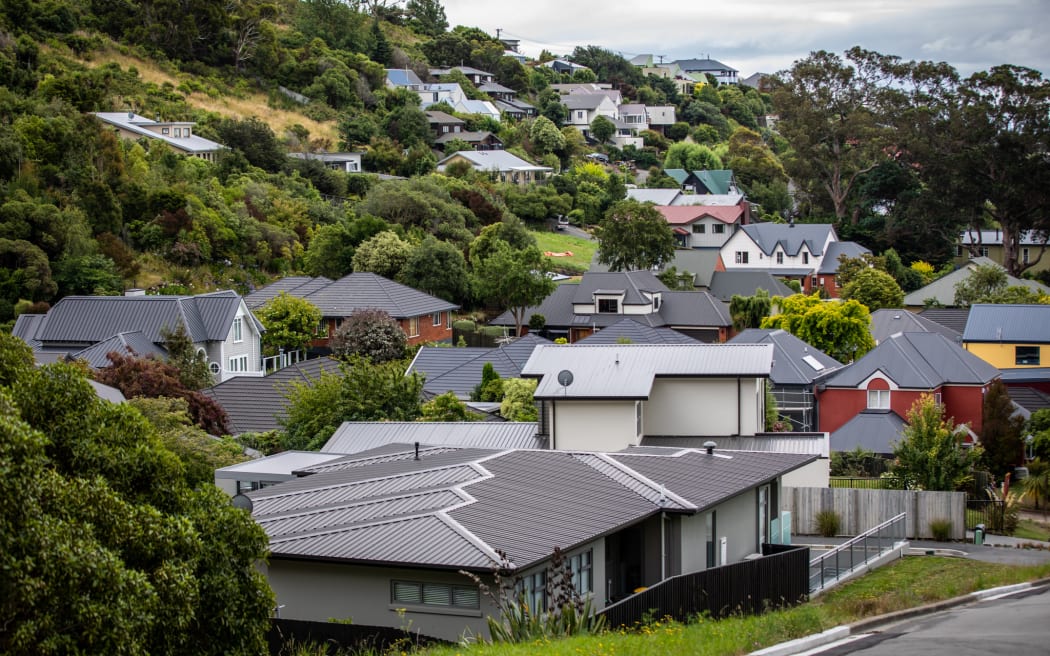
Photo: RNZ / Nate McKinnon
House prices need to fall at least another 16 percent to become anything like affordable, one forecaster says.
Housing Minister Chris Bishop caught attention last week when he said house prices needed to drop.
While affordability has been a political buzzword from successive governments, it is relatively rare to hear politicians say they want an outright drop in prices – it is often more politically palatable to wish for them to not rise so quickly.
Infometrics chief forecaster Gareth Kiernan said it was a “politically brave” statement for Bishop to have made.
According to the Real Estate Institute, prices remain 15.9 percent below their 2021 peak.
But house prices were on average 10.7 times personal income, which was higher than any time before 2020, Kiernan said.
Average house prices were 6.7 times household income, compared to a long-term average of 4.5. Debt servicing costs would take 43.4 percent of average household income, assuming someone had a 20 percent deposit, a 25-year mortgage term and an average-priced house on the lowest available mortgage rate.
To get back to that long-term average of 34.4 percent, allowing for a fall in interest rates to 5.9 percent, house prices would need to fall another 16 percent, he said.
“That decline would effectively take prices back to around where they were in the second half of 2020, which isn’t that long ago.
“However, to be clear, a further 16 percent decline in house prices wouldn’t make housing cheap, it would just make it more like average affordability.
“Returning house-price-to-income ratios to be in line with their long-term averages would require drops of between 32 percent [on the household income measure] and 38 percent [on personal incomes] Those kinds of declines would be much more difficult to sell politically.”
But independent economist Cameron Bagrie said house prices did not need to fall to become more affordable: “I agree in spirit with what [Bishop] meant but perhaps not what he actually said.”
He said it would be better for the economy if affordability improved due to incomes lifting more quickly than house prices.
Sustained falls in house prices would be worrying in terms of what it would mean for the general economy and the banking system, which was heavily exposed to housing loans, he said.
“Be careful what you wish for here.”
If there were 10 years of slow house price growth that lagged income growth it would create an orderly return of affordability, he said.
ANZ senior economist Miles Workman said a sharp fall in prices would carry significant confidence and wealth effects, which would result in a hard landing for the wider economy.
He said it could also exacerbate the fundamental problem of New Zealand not having enough housing supply.
“Any transition to more affordable levels is likely to be a lot less destructive if it’s driven by the supply side, where policies focusing on freeing up more land for development, housing intensification, and cutting red tape are important.
“Not all scenarios that involve house prices falling in the short run will lead to improved affordability in the longer run.
“The best medicine to our affordability problem is a supply response. That’s not something the [Reserve Bank] can do much about by moving the [Official Cash Rate] up and down as the business cycle ebbs and flows. This issue transcends the business cycle, and is therefore something for local and central government to tackle.”
Eric Crampton, chief economist at the NZ Initiative, said part of the solution would be to ease zoning rules that were creating scarcity.
“New Zealand’s house prices have been artificially inflated by zoning rules and consenting practices that have made it far too difficult to build new subdivisions, new townhouses, and new apartments. Easing that artificial scarcity would make housing more affordable,” he said.
A zoning change might push up the value of some properties because people would be able to build more dwellings on the land, he said.
“The value of other urban land could fall, if the zoned scarcity that contributes to its value eased. But the cost of housing would and should fall.”
House prices expected to bounce back faster: What is happening with the NZ housing market this week?
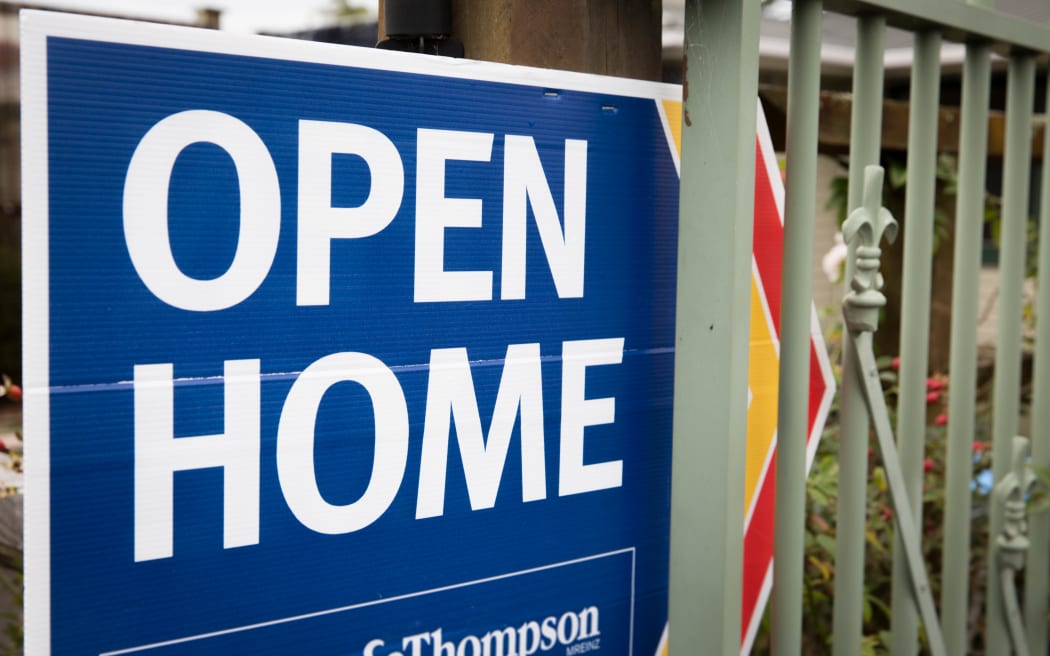
Westpac expects the market to pick up faster in 2025. File photo.
Photo: RNZ / Cole Eastham-Farrelly
Analysis – House price forecasts are low, but some banks are predicting a faster bounce back from next year. And looks like a big boost to housing supply is just around the corner. Here’s what moved real estate this week.
Westpac has significantly scaled back the amount of house price growth it expects this year.
It now expects growth of 2.1 percent – down from a previous estimate of 5.8 percent.
Slow momentum in the housing market since the election and the Reserve Bank’s “tough love” of high interest rates were the main reasons, Westpac said.
ASB and BNZ also dropped their forecasts recently. ASB expects 1 percent growth this year and BNZ 2 percent.
But Westpac still expected the market to pick up faster next year.
Significant population growth and a slowdown in construction would contribute to a shortage that could push prices up 6 percent in 2025, it said.
ANZ also downgraded its expectations for house price growth this year to 1 percent, from 3 percent. But it expected an increase of 4 percent next year.
Interest rates
A six-month home loan fix could be an option worth considering, ANZ economists said, because “significant falls” in mortgage rates may lie ahead.
They expected an “emergence of a downward trend” in wholesale rates over the coming months.
“Falls in mortgage rates will become more meaningful as we get nearer year-end and into next year.”
There was not a lot of difference between a six-month rate and a one-year rate at present, they said. ANZ’s forecast is for a one-year rate of about 5.7 percent next June.
Similarly, Kiwibank economist Sabrina Delgado expected the official cash rate (OCR) to be cut in November, earlier than many other forecasts. But the full impact of a fall in interest rates would be felt only next year.
She said 2025 was likely to be a year of “significant” interest rate cuts.
Kiwibank expected the OCR to be at 4.5 percent by next June, compared to 5.5 percent at present.
Once the Reserve Bank chose to cut rates, it would aim to scale right back to a neutral rate, Delgado told RNZ money correspondent Susan Edmunds.
The Reserve Bank had the economy “in a chokehold” and things would only start to improve once rates began to fall, she said.
She expected inflation to be back in the Reserve Bank’s target band of 1 percent to 3 percent by the third quarter of this year.
Buyers still keen
While affordability remained a “key hurdle” with high interest rates, CoreLogic chief property economist Kelvin Davidson said buyers were still watching the market and doing their due diligence.
“Until there is a bit more clarity about the potential timing for mortgage rates to start falling, it may still remain tricky for many people to convert a willingness to buy property into an actual deal,” he said.
Auckland new builds outpace population growth
Auckland, with nearly 65,000 new builds, has had the highest growth in new housing in New Zealand, far surpassing any other region. Canterbury was next with almost 26,000 new homes being built.
The surge in new houses had “helped” housing affordability, Auckland Council chief economist Gary Blick said, but housing in the city was still expensive relative to income.
Last year’s Census data showed Auckland new builds had outpaced the city’s population growth for the first time in decades.
Data showed there had been an 11.9 percent increase in new homes since then, while the population had increased by 5.4 percent.
Who is most likely to sell as bright-line test shortens?
The shortening of the bright-line test from 1 July would arguably drive more selling activity than buying, CoreLogic chief property economist Kelvin Davidson said.
The research firm said an early “escape” from capital gains tax would no doubt give some existing landlords reason to list.
But many would also hang on to their properties as there was already a glut of houses for sale and the rise in new listings from other investors might make it an unfavourable time to sell, Davidson said.
Investors who needed to top-up their rental income to cover an increase in mortgage repayments were more likely to sell than others, he said.
Consumer confidence falls
ANZ-Roy Morgan Consumer Confidence index fell another 2 points this month to 83 points, which well is below the 20-year average of 114.
Anything below 100 points indicated pessimism.
Two-year ahead inflation expectations bounced back to 4.2 percent, with house price inflation at 3.4 percent.
Inflation expectations were volatile but continued to trend lower, ANZ chief economist Sharon Zollner said.
However, Zollner said the latest reading pointed to tough times for retailers, as a net 23 percent of people still thought it was a bad time to buy a major appliance.
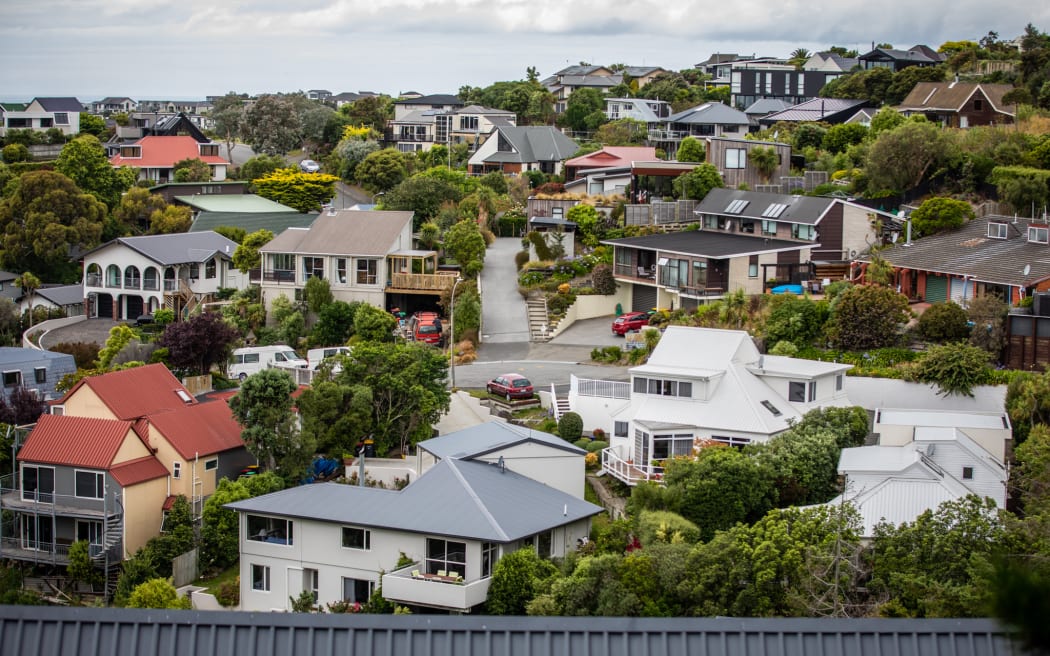
House sales are still a long way below the normal levels, says CoreLogic. File photo.
Photo: RNZ / Nate McKinnon
The housing market is seeing a modest recovery in sales volumes, although prices are flattening out with listings at elevated levels.
The CoreLogic NZ June Housing Chart Pack shows that a 9.2 percent annual increase in sales activity in May was still significantly below normal sales volumes.
CoreLogic NZ chief property economist Kelvin Davidson said sales activity increased for the 13th consecutive month in May to 6789 transactions. However, the number of deals being done remained subdued.
“At 73,181 deals in the past 12 months, sales are still a long way below the normal levels of about 90,000 per year,” he said.
“This relatively quiet market in terms of sales activity means new listings coming to market are adding to the overall inventory, putting buyers in the box seat when it comes to negotiating prices.”
Total stock was 16 percent higher than the same time last year and nearly 28 percent above the five-year average.
“New listings activity has been solid although not spectacular so far in 2024, and it would appear that some ‘pent up’ reluctance to list in the final few months of last year is now coming forward and turning into available stock this year,” he said.
First home buyers continued to represent 25 percent of purchases helped along with lower house prices, less competition from other buyer groups, a KiwiSaver for the deposit, as well as access to low-deposit finance at the banks.
Relocating owner-occupiers, with a 26 percent share of purchases, were starting to show signs of a small comeback
“Movers were relatively quiet during the pandemic years, possibly due to a lack of choice in available listings and reliance on conditionals offers, usually related to requiring finance or needing to sell prior,” Davidson said.
“Now that listings have lifted and there’s greater choice in the market, it’s possible owner-occupiers are acting on that pent-up demand due to need or want.”
He said regulation and rule changes remained a key theme in the property market.
“In an environment where mortgage rates remain high and aren’t set to fall materially for a while yet, this year remains pretty underwhelming for the property market, despite a raft of policy changes,” he said.
“Data suggests that values have been losing momentum since March and the patchy recovery that many areas of New Zealand had been experiencing has slowed, or in some cases reversed.”
Davidson said the market’s recovery over 2023 was largely due to a resilient labour market and strong net migration, which had passed its peak.
“The more recent loss of momentum is a reflection of prolonged affordability pressures, persistent high mortgage rates, an increase in listings on the market, and a turning point for unemployment,” he said.
“Tax cuts and a loosening in the LVR rules are unlikely to make a material impact on transactions or prices given we’re in an environment where mortgage rates remain high.”










